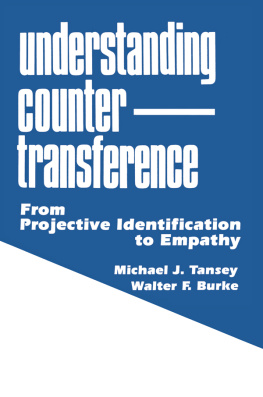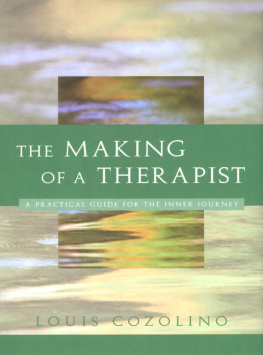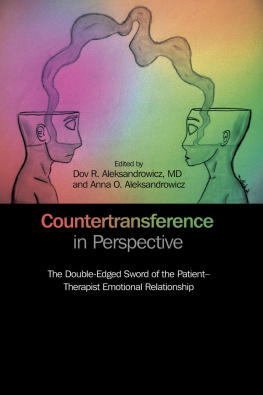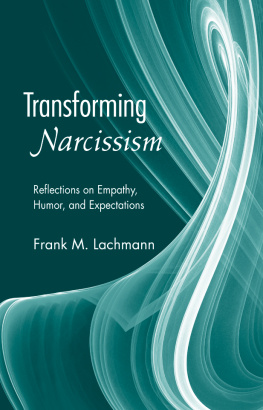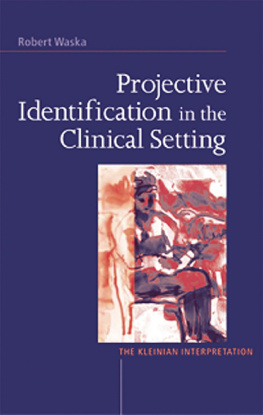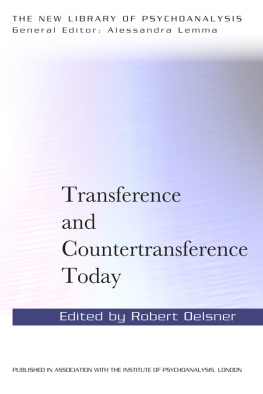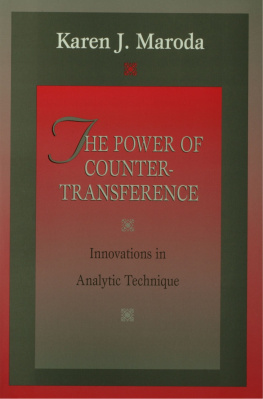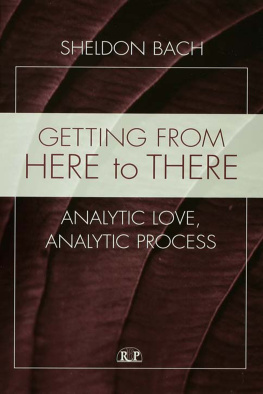
UNDERSTANDING COUNTERTRANSFERENCE
From Projective Identification to Empathy
Michael J. Tansey
Walter F. Burke
UNDERSTANDING COUNTERTRANSFERENCE
From Projective Identification to Empathy

First Published by
The Analytic Press, Inc.
Editorial Offices: 101 West Street
Hillsdale, NJ 07642
Transferred to Digital Printing 2009 by Psychology Press
270 Madison Avenue, New York NY 10016
27 Church Road, Hove, East Sussex BN3 2FA
Copyright 1989 by The Analytic Press, Inc.
All rights reserved. No part of this book may be reproduced in any form: by photostat, microform, retrieval system, or any other means, without the prior written permission of the publisher.
First paperback printing 1995
Library of Congress Cataloging-in-Publication Data
Tansey, Michael J.
Understanding countertransference.
Bibliography; p.
Includes index.
1. Countertransference I. Burke, Walter F. II. Title.
RC489.C68T36 1989 616.8914 88-24217
ISBN 0-88163-227-9
Publishers Note
The publisher has gone to great lengths to ensure the quality of this reprint but points out that some imperfections in the original may be apparent.
To my parents, Connie and Walter
W. F. B.
To Pamela
M. J. T.
I had seen so many people all my lifeI was an average mixer, but more than average in a tendency to identify myself, my ideas, my destiny, with those of all classes that I came in contact with. I had become identified with the objects of horror or compassion identification such as this spells the death of accomplishment. It is something like this that keeps insane people from working.
F. Scott Fitzgerald, The Crack Up, 1936
The inspiration for this work came predominantly from our association with Dr. Merton Gill. Having participated in his psychotherapy seminar during graduate school, we were fortunate enough to be able to form a weekly study group with him upon graduation. That group began in 1978, continues to meet, and has exerted a major impact upon clinical psychology throughout the city of Chicago. Unlike many others who have achieved eminence in this field, Merton has always encouraged independent thinking rather than conformity. He relishes spirited debate and is remarkably able to concede a point when the weight of clinical material calls for modifying his position. He has shown us by example that one need not expect perfection or omniscence from oneself, either as a teacher or as a therapist. Both by his words andmuch more importantlyby his example, he established an attitude and tone within the study group that facilitated and encouraged the examination of often difficult countertransference experiences.
As we listened to audio-taped presentations of clinical material, a very common pattern caught our attention: because the study group was experienced as wonderfully helpful, each presenter typically brought in a difficult case, rather than one that would simply reflect his competency. Very often the difficulty revolved around some form of countertransference disturbance, producing such feelings as discomfort, self-doubt, and loss of perspective. With the groups insight and support, the therapist was frequently able to identify and acknowledge uncomfortable thoughts, feelings, and urges toward the patient. Time and again, it became clear that the disruptive counter-transference response had in some way been brought on not only by the personal issues of the therapist, but also by the influence of the patient. Understanding the nature, source, and meanings of the patients influence inevitably proved to be extremely valuable to the treatment process.
Because each therapist typically presented three or four times before we moved on to the next case, the group had the opportunity to test hypotheses by observing how the therapist chose to incorporate input from the group into his interventions, and how the patient subsequently responded. In addition, we often had the opportunity to hear the same case presented a year or two later. Consistently, we concluded that a greater understanding of the patient, the therapist, and the interaction evolved out of episodes of countertransference disturbance. Although the study group was organized out of a collective interest in Merton Gills ideas regarding transference phenomena, we were inexorably led in the direction of understanding the therapists experience as a vehicle for fathoming the patients experience. We were then led quite naturally to a study of the literature pertaining to empathy, projective identification, and countertransference, the three most important concepts (along with transference) that bridge the intrapsychic and interpersonal realms.
We are profoundly grateful to Merton for all that he has done for us in fostering our professional growth over the years. We thank him for his encouragement and direction in the completion of this project. To the dozens of psychologists who have participated in this study group since inception, we also express our thanks.
From the study group, from our research of the literature, and from our cumulative clinical and supervisory experience, we came away with several questions that are addressed in this volume. How is the patient able to induce within the therapist those feeling states that so closely parallel or complement his own? What are the specific steps by which a therapist, struggling with countertransference, can extricate himself from the intensity of his experience, however pleasant or unpleasant it may be? Having extricated himself, how does he make use of the experience to further his understanding of the patient? How does he determine the extent of his own contribution to his counter-transference response versus the extent of the patients interpersonal influence? Lastly, how does the therapist decide on the content and timing of his interventions, which are grounded in understanding of his countertransference? When is countertransference disclosure useful and when is it not? We do not feel that these questions have been adequately addressed in the existing literature.
We were influenced and inspired too by Dr. Charles Donnelly, who died suddenly in 1987. His encouragement and his dedication to our professional development were strong factors in the early work leading up to this volume. His interest in understanding processes of internalization from the framework of ego psychology helped us to address the intrapsychic experience of the therapist caught in a countertransference storm. Above all, Charlie demonstrated an unwavering commitment to the application of psychoanalytic methods to severely disturbed patients. He thus helped to convince us that psychoanalytic concepts most often exist along a continuum and are not justifiably segregated according to indices of psychopathology.
For the variety of ways in which they assisted in the overall preparation of this book, we wish to thank Drs. Paula Gorlitz, Beth Carone, Norman Schaffer, Ronald Ganellen, Oliver Kerner, Craig Johnson, and Ted Stevens.
Lissa Petes diligent efforts in typing and word processing the volume were nothing short of heroic. She was able to transform handwritten or hastily dictated material into comprehensible copy. Her dedication and resourcefulness quite literally made this publication possible.
Lastly, we are grateful to Eleanor Starke Kobrin for her editorial assistance in polishing the manuscript, and to Dr. Paul E. Stepansky, editor-in-chief of The Analytic Press, for his encouragement, patience, and reliability. We remain incredulous that he once responded in less than a week to five chapters of manuscript with three pages of detailed, thoughtful commentary.
Next page
